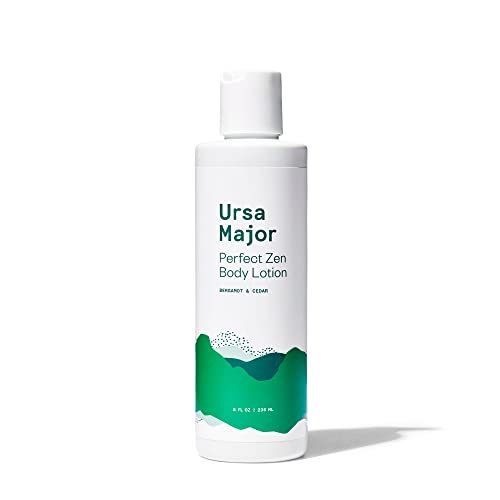
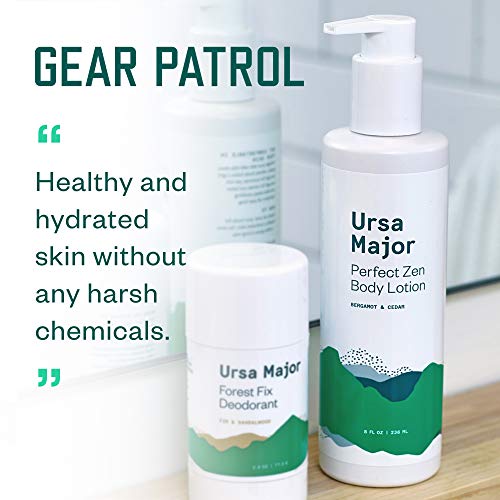
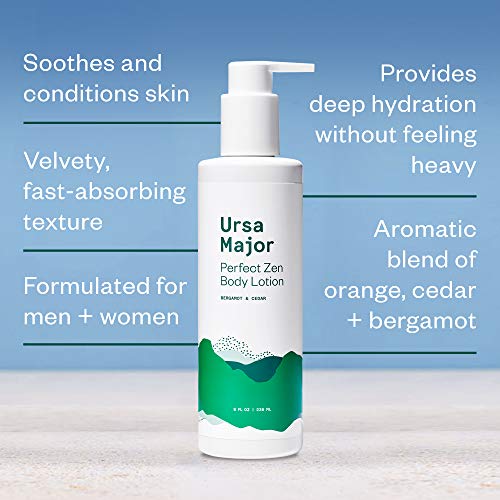
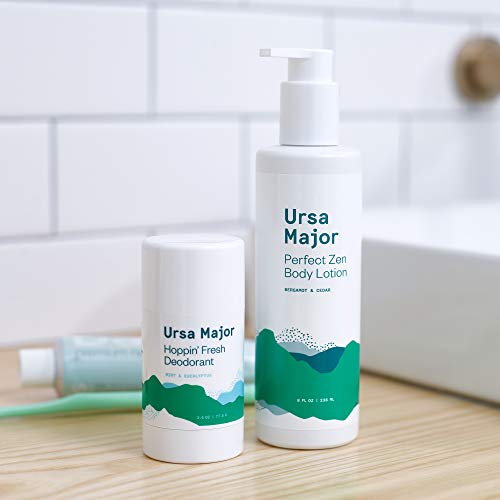
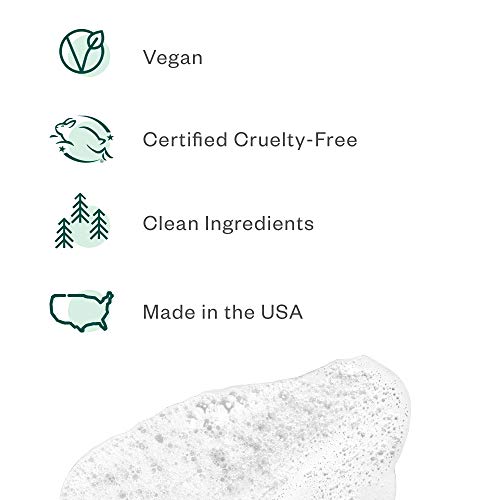
Ursa Major Body Lotion - Hydrating, Soothes Skin, Vegan & Cruelty-Free - 8oz Pump


Benzyl Alcohol
High RiskBenzyl alcohol is a naturally occurring and synthetic aromatic alcohol commonly used as a solvent, preservative, and fragrance ingredient in various products. It is found in both plant sources and as a synthetic compound, functioning primarily to maintain product stability and enhance fragrance profiles.
Sustai Insights
Benzyl alcohol serves effectively as a preservative and solvent, contributing to product stability and sensory qualities. However, it poses potential health risks, particularly as an allergen, with high concern for immunotoxicity. Environmental risks include being a pollutant with low bioaccumulation potential. Regulatory agencies have established restrictions on its use in certain products. Overall, the risk level associated with benzyl alcohol is assessed as high, necessitating careful consideration of its use and potential alternatives.
Citrus Aurantium Dulcis (Orange) Peel Oil
Medium RiskCitrus aurantium dulcis (orange) peel oil is derived from the peel of oranges and is commonly used in cosmetic and personal care products for its fragrance and potential skin benefits. It is known for its aromatic properties and is often included in formulations aimed at enhancing scent profiles.
Sustai Insights
Citrus aurantium dulcis (orange) peel oil offers functional benefits such as providing a pleasant scent and potential antimicrobial properties. However, it poses a high allergy risk and may cause skin irritation in sensitive individuals. Environmental concerns include moderate persistence and potential to contribute to pollution. Regulatory warnings indicate restrictions on use in certain products. Overall, the risk level is assessed as medium, and users are advised to practice caution, particularly those with known allergies. Alternatives like sweet orange essential oil may provide similar benefits with potentially lower risks.
Rosmarinus Officinalis (Rosemary) Leaf Oil
Medium RiskRosmarinus officinalis (rosemary) leaf oil is extracted from the leaves of the rosemary plant. It is commonly used in cosmetic and personal care products for its aromatic properties and potential preservative benefits due to its antioxidant content.
Sustai Insights
Rosemary leaf oil offers functional benefits such as antimicrobial and antioxidant properties, which can enhance product stability. It is derived from a renewable source and is biodegradable. However, it presents moderate risks of allergic reactions and skin irritation, particularly with enhanced skin absorption. Regulatory bodies have noted restrictions on its usage in specific concentrations. The overall risk level is assessed as medium. Users are advised to follow safe usage practices and may consider alternatives like tocopherols or other natural preservatives.
Citrus Reticulata Oil
Medium RiskCitrus reticulata oil is derived from the whole plant of any subspecies within the citrus reticulata species. It is commonly used in various products for its aromatic properties and potential benefits in formulations.
Sustai Insights
Citrus reticulata oil serves as a fragrance and may offer some antimicrobial properties, which can enhance product appeal. However, it is associated with high allergenic potential, posing risks for sensitive individuals. There are moderate use restrictions noted, and it may persist in the environment, raising concerns about ecological impact. Overall, the ingredient is assessed as having a medium risk level, necessitating safe usage practices and consideration of alternatives for those seeking lower-risk options.
Rosmarinus Officinalis (Rosemary) Leaf Extract
Medium RiskRosemary leaf extract is produced from the leaves of the Rosmarinus officinalis plant. It is commonly used in cosmetic formulations for its potential antioxidant properties and fragrance. The extract may also contribute to the preservation of products due to its antimicrobial characteristics.
Sustai Insights
Rosemary leaf extract offers functional benefits such as antioxidant and antimicrobial properties, which can enhance product stability and shelf-life. It is generally considered low risk for carcinogenicity and reproductive toxicity, but it carries a moderate potential for allergic reactions. Environmentally, it poses low risk with no significant pollutant or bioaccumulation concerns. Regulatory bodies have not placed significant restrictions on its use, although some verified products cannot contain certain concentrations. Overall, the ingredient's risk level is medium, necessitating careful usage practices to mitigate allergic responses.
Cetearyl Alcohol
Low RiskCetearyl alcohol is a mixture of cetyl and stearyl alcohol, primarily used as an emulsifier and thickener in cosmetic formulations. It helps stabilize products, improve texture, and enhance moisturizing properties, making it common in creams and lotions.
Sustai Insights
Cetearyl alcohol offers functional benefits as an effective emulsifier and skin-conditioning agent, contributing to product stability and texture. It is generally recognized as safe, with low concerns for carcinogenicity, allergies, or reproductive toxicity. Environmental risks are minimal, as it is biodegradable and has low pollutant potential. Regulatory bodies have not imposed significant restrictions on its use. Overall, cetearyl alcohol is assessed to carry low risk, making it a suitable ingredient choice in cosmetic products.
Cetearyl Glucoside
Low RiskCetearyl glucoside is a surfactant and emulsifier derived from natural sources, commonly used in cosmetic and personal care products to stabilize formulations and enhance texture. It helps to blend oil and water-based ingredients, improving product consistency and application.
Sustai Insights
Cetearyl glucoside offers functional benefits as an effective emulsifier and surfactant, facilitating product stability. Its sustainability credentials are notable, as it is biodegradable and sourced from renewable materials. Health risks are generally low, with minimal concerns for irritation and allergies. Environmental impacts are also low, posing no significant pollution or bioaccumulation risks. Regulatory status remains positive with no major restrictions reported. Safe usage practices are advised, and alternatives such as plant-derived emulsifiers may be considered. Overall, the risk level associated with cetearyl glucoside is low.
Aloe Barbadensis (Aloe Vera) Leaf Extract
Low RiskAloe vera leaf extract is produced from the succulent leaves of the Aloe barbadensis plant. It is commonly used in cosmetic formulations for its moisturizing and soothing properties, making it a popular ingredient in skincare and personal care products.
Sustai Insights
Aloe vera leaf extract offers several functional benefits, including hydration and skin soothing effects, which are well-supported by scientific literature. It is considered to have a low risk for common health concerns such as carcinogenicity, allergies, or reproductive toxicity. Environmentally, it poses minimal risks, with no significant pollutant potential or bioaccumulation reported. Regulatory bodies have not imposed major restrictions, although verified products should not contain certain contaminants. Overall, this ingredient is assessed as low risk, with safe usage practices and the availability of alternative soothing agents if desired.
Xanthan Gum
Low RiskXanthan gum is a polysaccharide, a sugar-based compound produced by the fermentation of glucose or sucrose. It is commonly used as a thickening agent and stabilizer in various food and cosmetic products due to its ability to improve texture and prevent ingredient separation.
Sustai Insights
Xanthan gum serves effectively as a thickener and stabilizer, enhancing product texture and consistency. It is biodegradable and typically derived from renewable sources, supporting sustainability efforts. Health risks are minimal, with low concerns regarding carcinogenicity, allergies, and reproductive toxicity. Environmental impact is similarly low, posing no significant hazards. Regulatory agencies, including the FDA, regard it as safe for use, with no significant restrictions. Overall, xanthan gum is assessed as low risk, making it a suitable ingredient in formulations.
Cetyl Palmitate
Low RiskCetyl palmitate is a lipid ingredient derived from cetyl alcohol and palmitic acid. It functions primarily as an emulsifier and thickening agent in cosmetic formulations, helping to stabilize and improve the texture of products such as creams and lotions.
Sustai Insights
Cetyl palmitate offers functional benefits as an effective emulsifier, enhancing product stability and texture. It is generally regarded as having low health risks, with minimal concerns regarding carcinogenicity, allergies, and irritation. Environmentally, it poses low risks and is not known for bioaccumulation. Regulatory bodies have not issued significant warnings, indicating compliance with safety standards. Overall, cetyl palmitate presents a low risk profile, making it a suitable choice in cosmetic formulations. For those seeking alternatives, other plant-based emulsifiers may provide similar functionality.
Cedarwood Oil
Low RiskCedarwood oil is an essential oil derived from cedar trees, primarily used for its aromatic properties and as a natural ingredient in personal care products. It serves various functions, including acting as a fragrance, a potential preservative, and an insect repellent.
Sustai Insights
Cedarwood oil offers functional benefits, such as providing a pleasant scent and potential preservation properties due to its antimicrobial effects. It is sustainably sourced and biodegradable. Health-wise, it has low concerns regarding carcinogenicity, allergies, and reproductive toxicity. Environmentally, it poses low risks as a pollutant and is not bioaccumulative. Regulatory bodies have not issued significant warnings, confirming its low-risk status. Safe usage practices should be followed, and alternatives include plant-based essential oils with similar benefits. Overall, cedarwood oil is assessed with a low risk level.
Caprylic Triglyceride
Low RiskCaprylic triglyceride is an ester derived from coconut oil and glycerin, commonly used in cosmetic formulations as an emollient, stabilizer, and skin-conditioning agent. It helps to improve the texture and spreadability of products while providing a lightweight, non-greasy feel.
Sustai Insights
Caprylic triglyceride offers functional benefits such as enhanced skin moisturization and improved formulation stability. It is generally regarded as safe, with low concerns regarding carcinogenicity, allergenic potential, and reproductive toxicity. Environmental impact is minimal, with no significant pollutant or bioaccumulative properties identified. Regulatory bodies have not issued warnings or restrictions. Overall, the risk level is low, making it a suitable ingredient in cosmetic products. Safe usage practices include adhering to recommended concentrations, and while there are alternatives, caprylic triglyceride remains a reliable choice.
Limnanthes Versicolor (Meadowfoam) Seed Oil
Low RiskLimnanthes versicolor (meadowfoam) seed oil is derived from the seeds of the meadowfoam plant. It is commonly used in cosmetic formulations for its emollient properties, providing moisture and improving texture in skin and hair care products.
Sustai Insights
Meadowfoam seed oil offers functional benefits as a moisturizer and skin conditioner, being sustainably sourced and biodegradable. Health risks are minimal, with low concerns for carcinogenicity, allergies, and reproductive toxicity. Environmental risks are also low, with no significant pollutant potential. Current regulatory assessments do not indicate restrictions. Overall, this ingredient poses a low-risk profile, making it a suitable choice in cosmetic formulations.
Helianthus Annuus (Sunflower) Seed
Low RiskHelianthus annuus (sunflower) seed is derived from the seeds of the sunflower plant and is commonly used in various cosmetic and personal care products. It serves primarily as an emollient and skin conditioning agent, providing moisture and enhancing the texture of formulations.
Sustai Insights
Helianthus annuus (sunflower) seed offers functional benefits, including skin conditioning and moisturizing properties, while being sustainably sourced and biodegradable. Health risks are minimal, with low concerns for carcinogenicity, allergies, and reproductive toxicity. Environmentally, it presents low risks of pollution or bioaccumulation. Regulatory assessments indicate no current restrictions. Overall, it is considered a low-risk ingredient, and safe usage practices should be maintained. Alternative ingredients may include other plant-based oils, but the sunflower seed oil remains a viable option.
Vegetarian Glycerin
Low RiskVegetarian glycerin, also known as glycerol, is a colorless, odorless, and viscous liquid derived from plant sources. It is primarily used as a humectant, solvent, and emollient in various personal care products, helping to retain moisture and improve texture.
Sustai Insights
Vegetarian glycerin offers functional benefits as an effective humectant, promoting hydration and skin smoothness. It is biodegradable and typically sustainably sourced. Health risks associated with glycerin are low, with no significant concerns for carcinogenicity, allergens, or reproductive toxicity. Environmental risks are minimal, and it is not subject to major regulatory warnings. Overall, the risk level for this ingredient is low, making it a safe choice in formulations. Safe usage practices include ensuring proper concentrations in products, and alternatives such as propylene glycol exist but may have differing properties.
Dehydroacetic Acid
Low RiskDehydroacetic acid is a synthetic preservative commonly used in cosmetic and personal care products to inhibit microbial growth and extend shelf life.
Sustai Insights
Dehydroacetic acid offers effective preservation, enhancing product stability. It is considered low risk for carcinogenicity, allergies, and reproductive toxicity, with minimal environmental impact. Regulatory bodies report no significant hazards, and its use is generally accepted. However, precautions should be taken to avoid occupational exposure. Alternatives include natural preservatives like tocopherol. Overall, the assessment indicates a low-risk profile.
Lavandula Angustifolia (Lavender) Flower Oil
Low RiskLavandula angustifolia (lavender) flower oil is an essential oil derived from the flowers of the lavender plant. It is commonly used in personal care products for its aromatic properties and is known for its potential soothing effects in formulations.
Sustai Insights
Lavender oil provides functional benefits such as fragrance enhancement and potential calming effects, contributing to user experience in various personal care products. It is sustainably sourced and has low toxicity levels. Health risks associated with lavender oil are minimal, with low concerns for carcinogenicity, allergies, and reproductive toxicity. Environmental risks are also low, with no significant pollutant concerns. Regulatory assessments indicate no current restrictions, affirming its safety for use. Overall, the ingredient is considered low risk, making it a favorable choice in formulations.
Benzyl Alcohol
High RiskBenzyl alcohol is a naturally occurring and synthetic aromatic alcohol commonly used as a solvent, preservative, and fragrance ingredient in various products. It is found in both plant sources and as a synthetic compound, functioning primarily to maintain product stability and enhance fragrance profiles.
Sustai Insights
Benzyl alcohol serves effectively as a preservative and solvent, contributing to product stability and sensory qualities. However, it poses potential health risks, particularly as an allergen, with high concern for immunotoxicity. Environmental risks include being a pollutant with low bioaccumulation potential. Regulatory agencies have established restrictions on its use in certain products. Overall, the risk level associated with benzyl alcohol is assessed as high, necessitating careful consideration of its use and potential alternatives.
Cetearyl Alcohol
Low RiskCetearyl alcohol is a mixture of cetyl and stearyl alcohol, primarily used as an emulsifier and thickener in cosmetic formulations. It helps stabilize products, improve texture, and enhance moisturizing properties, making it common in creams and lotions.
Sustai Insights
Cetearyl alcohol offers functional benefits as an effective emulsifier and skin-conditioning agent, contributing to product stability and texture. It is generally recognized as safe, with low concerns for carcinogenicity, allergies, or reproductive toxicity. Environmental risks are minimal, as it is biodegradable and has low pollutant potential. Regulatory bodies have not imposed significant restrictions on its use. Overall, cetearyl alcohol is assessed to carry low risk, making it a suitable ingredient choice in cosmetic products.
Cetearyl Glucoside
Low RiskCetearyl glucoside is a surfactant and emulsifier derived from natural sources, commonly used in cosmetic and personal care products to stabilize formulations and enhance texture. It helps to blend oil and water-based ingredients, improving product consistency and application.
Sustai Insights
Cetearyl glucoside offers functional benefits as an effective emulsifier and surfactant, facilitating product stability. Its sustainability credentials are notable, as it is biodegradable and sourced from renewable materials. Health risks are generally low, with minimal concerns for irritation and allergies. Environmental impacts are also low, posing no significant pollution or bioaccumulation risks. Regulatory status remains positive with no major restrictions reported. Safe usage practices are advised, and alternatives such as plant-derived emulsifiers may be considered. Overall, the risk level associated with cetearyl glucoside is low.
Aloe Barbadensis (Aloe Vera) Leaf Extract
Low RiskAloe vera leaf extract is produced from the succulent leaves of the Aloe barbadensis plant. It is commonly used in cosmetic formulations for its moisturizing and soothing properties, making it a popular ingredient in skincare and personal care products.
Sustai Insights
Aloe vera leaf extract offers several functional benefits, including hydration and skin soothing effects, which are well-supported by scientific literature. It is considered to have a low risk for common health concerns such as carcinogenicity, allergies, or reproductive toxicity. Environmentally, it poses minimal risks, with no significant pollutant potential or bioaccumulation reported. Regulatory bodies have not imposed major restrictions, although verified products should not contain certain contaminants. Overall, this ingredient is assessed as low risk, with safe usage practices and the availability of alternative soothing agents if desired.
Xanthan Gum
Low RiskXanthan gum is a polysaccharide, a sugar-based compound produced by the fermentation of glucose or sucrose. It is commonly used as a thickening agent and stabilizer in various food and cosmetic products due to its ability to improve texture and prevent ingredient separation.
Sustai Insights
Xanthan gum serves effectively as a thickener and stabilizer, enhancing product texture and consistency. It is biodegradable and typically derived from renewable sources, supporting sustainability efforts. Health risks are minimal, with low concerns regarding carcinogenicity, allergies, and reproductive toxicity. Environmental impact is similarly low, posing no significant hazards. Regulatory agencies, including the FDA, regard it as safe for use, with no significant restrictions. Overall, xanthan gum is assessed as low risk, making it a suitable ingredient in formulations.
Cetyl Palmitate
Low RiskCetyl palmitate is a lipid ingredient derived from cetyl alcohol and palmitic acid. It functions primarily as an emulsifier and thickening agent in cosmetic formulations, helping to stabilize and improve the texture of products such as creams and lotions.
Sustai Insights
Cetyl palmitate offers functional benefits as an effective emulsifier, enhancing product stability and texture. It is generally regarded as having low health risks, with minimal concerns regarding carcinogenicity, allergies, and irritation. Environmentally, it poses low risks and is not known for bioaccumulation. Regulatory bodies have not issued significant warnings, indicating compliance with safety standards. Overall, cetyl palmitate presents a low risk profile, making it a suitable choice in cosmetic formulations. For those seeking alternatives, other plant-based emulsifiers may provide similar functionality.
Cedarwood Oil
Low RiskCedarwood oil is an essential oil derived from cedar trees, primarily used for its aromatic properties and as a natural ingredient in personal care products. It serves various functions, including acting as a fragrance, a potential preservative, and an insect repellent.
Sustai Insights
Cedarwood oil offers functional benefits, such as providing a pleasant scent and potential preservation properties due to its antimicrobial effects. It is sustainably sourced and biodegradable. Health-wise, it has low concerns regarding carcinogenicity, allergies, and reproductive toxicity. Environmentally, it poses low risks as a pollutant and is not bioaccumulative. Regulatory bodies have not issued significant warnings, confirming its low-risk status. Safe usage practices should be followed, and alternatives include plant-based essential oils with similar benefits. Overall, cedarwood oil is assessed with a low risk level.
Citrus Aurantium Dulcis (Orange) Peel Oil
Medium RiskCitrus aurantium dulcis (orange) peel oil is derived from the peel of oranges and is commonly used in cosmetic and personal care products for its fragrance and potential skin benefits. It is known for its aromatic properties and is often included in formulations aimed at enhancing scent profiles.
Sustai Insights
Citrus aurantium dulcis (orange) peel oil offers functional benefits such as providing a pleasant scent and potential antimicrobial properties. However, it poses a high allergy risk and may cause skin irritation in sensitive individuals. Environmental concerns include moderate persistence and potential to contribute to pollution. Regulatory warnings indicate restrictions on use in certain products. Overall, the risk level is assessed as medium, and users are advised to practice caution, particularly those with known allergies. Alternatives like sweet orange essential oil may provide similar benefits with potentially lower risks.
Caprylic Triglyceride
Low RiskCaprylic triglyceride is an ester derived from coconut oil and glycerin, commonly used in cosmetic formulations as an emollient, stabilizer, and skin-conditioning agent. It helps to improve the texture and spreadability of products while providing a lightweight, non-greasy feel.
Sustai Insights
Caprylic triglyceride offers functional benefits such as enhanced skin moisturization and improved formulation stability. It is generally regarded as safe, with low concerns regarding carcinogenicity, allergenic potential, and reproductive toxicity. Environmental impact is minimal, with no significant pollutant or bioaccumulative properties identified. Regulatory bodies have not issued warnings or restrictions. Overall, the risk level is low, making it a suitable ingredient in cosmetic products. Safe usage practices include adhering to recommended concentrations, and while there are alternatives, caprylic triglyceride remains a reliable choice.
Limnanthes Versicolor (Meadowfoam) Seed Oil
Low RiskLimnanthes versicolor (meadowfoam) seed oil is derived from the seeds of the meadowfoam plant. It is commonly used in cosmetic formulations for its emollient properties, providing moisture and improving texture in skin and hair care products.
Sustai Insights
Meadowfoam seed oil offers functional benefits as a moisturizer and skin conditioner, being sustainably sourced and biodegradable. Health risks are minimal, with low concerns for carcinogenicity, allergies, and reproductive toxicity. Environmental risks are also low, with no significant pollutant potential. Current regulatory assessments do not indicate restrictions. Overall, this ingredient poses a low-risk profile, making it a suitable choice in cosmetic formulations.
Helianthus Annuus (Sunflower) Seed
Low RiskHelianthus annuus (sunflower) seed is derived from the seeds of the sunflower plant and is commonly used in various cosmetic and personal care products. It serves primarily as an emollient and skin conditioning agent, providing moisture and enhancing the texture of formulations.
Sustai Insights
Helianthus annuus (sunflower) seed offers functional benefits, including skin conditioning and moisturizing properties, while being sustainably sourced and biodegradable. Health risks are minimal, with low concerns for carcinogenicity, allergies, and reproductive toxicity. Environmentally, it presents low risks of pollution or bioaccumulation. Regulatory assessments indicate no current restrictions. Overall, it is considered a low-risk ingredient, and safe usage practices should be maintained. Alternative ingredients may include other plant-based oils, but the sunflower seed oil remains a viable option.
Vegetarian Glycerin
Low RiskVegetarian glycerin, also known as glycerol, is a colorless, odorless, and viscous liquid derived from plant sources. It is primarily used as a humectant, solvent, and emollient in various personal care products, helping to retain moisture and improve texture.
Sustai Insights
Vegetarian glycerin offers functional benefits as an effective humectant, promoting hydration and skin smoothness. It is biodegradable and typically sustainably sourced. Health risks associated with glycerin are low, with no significant concerns for carcinogenicity, allergens, or reproductive toxicity. Environmental risks are minimal, and it is not subject to major regulatory warnings. Overall, the risk level for this ingredient is low, making it a safe choice in formulations. Safe usage practices include ensuring proper concentrations in products, and alternatives such as propylene glycol exist but may have differing properties.
Dehydroacetic Acid
Low RiskDehydroacetic acid is a synthetic preservative commonly used in cosmetic and personal care products to inhibit microbial growth and extend shelf life.
Sustai Insights
Dehydroacetic acid offers effective preservation, enhancing product stability. It is considered low risk for carcinogenicity, allergies, and reproductive toxicity, with minimal environmental impact. Regulatory bodies report no significant hazards, and its use is generally accepted. However, precautions should be taken to avoid occupational exposure. Alternatives include natural preservatives like tocopherol. Overall, the assessment indicates a low-risk profile.
Lavandula Angustifolia (Lavender) Flower Oil
Low RiskLavandula angustifolia (lavender) flower oil is an essential oil derived from the flowers of the lavender plant. It is commonly used in personal care products for its aromatic properties and is known for its potential soothing effects in formulations.
Sustai Insights
Lavender oil provides functional benefits such as fragrance enhancement and potential calming effects, contributing to user experience in various personal care products. It is sustainably sourced and has low toxicity levels. Health risks associated with lavender oil are minimal, with low concerns for carcinogenicity, allergies, and reproductive toxicity. Environmental risks are also low, with no significant pollutant concerns. Regulatory assessments indicate no current restrictions, affirming its safety for use. Overall, the ingredient is considered low risk, making it a favorable choice in formulations.
Rosmarinus Officinalis (Rosemary) Leaf Oil
Medium RiskRosmarinus officinalis (rosemary) leaf oil is extracted from the leaves of the rosemary plant. It is commonly used in cosmetic and personal care products for its aromatic properties and potential preservative benefits due to its antioxidant content.
Sustai Insights
Rosemary leaf oil offers functional benefits such as antimicrobial and antioxidant properties, which can enhance product stability. It is derived from a renewable source and is biodegradable. However, it presents moderate risks of allergic reactions and skin irritation, particularly with enhanced skin absorption. Regulatory bodies have noted restrictions on its usage in specific concentrations. The overall risk level is assessed as medium. Users are advised to follow safe usage practices and may consider alternatives like tocopherols or other natural preservatives.
Citrus Reticulata Oil
Medium RiskCitrus reticulata oil is derived from the whole plant of any subspecies within the citrus reticulata species. It is commonly used in various products for its aromatic properties and potential benefits in formulations.
Sustai Insights
Citrus reticulata oil serves as a fragrance and may offer some antimicrobial properties, which can enhance product appeal. However, it is associated with high allergenic potential, posing risks for sensitive individuals. There are moderate use restrictions noted, and it may persist in the environment, raising concerns about ecological impact. Overall, the ingredient is assessed as having a medium risk level, necessitating safe usage practices and consideration of alternatives for those seeking lower-risk options.
Rosmarinus Officinalis (Rosemary) Leaf Extract
Medium RiskRosemary leaf extract is produced from the leaves of the Rosmarinus officinalis plant. It is commonly used in cosmetic formulations for its potential antioxidant properties and fragrance. The extract may also contribute to the preservation of products due to its antimicrobial characteristics.
Sustai Insights
Rosemary leaf extract offers functional benefits such as antioxidant and antimicrobial properties, which can enhance product stability and shelf-life. It is generally considered low risk for carcinogenicity and reproductive toxicity, but it carries a moderate potential for allergic reactions. Environmentally, it poses low risk with no significant pollutant or bioaccumulation concerns. Regulatory bodies have not placed significant restrictions on its use, although some verified products cannot contain certain concentrations. Overall, the ingredient's risk level is medium, necessitating careful usage practices to mitigate allergic responses.
Discover the Ursa Major Natural Body Lotion, a luxurious, vegan, and cruelty-free moisturizer designed for year-round hydration. This lightweight yet rich formula offers deep nourishment, making it perfect for all skin types, whether in summer or winter.
- Deep Hydration: Infused with hydrating aloe and moisture-retaining sunflower oil, this lotion ensures your skin feels soft and supple all day long.
- Gentle and Clean: Free from parabens, sulfates, and synthetic fragrances, it prioritizes your health and the planet, making it ideal for sensitive skin.
- Refreshing Aroma: Experience a verdant blend of essential oils, including sweet orange and lavender, that uplifts your senses with every application.
- Versatile Use: Perfect for both men and women, this body lotion doubles as a soothing hand cream, making it a great addition to your daily routine.
- Easy Application: Comes with a convenient pump cap for mess-free dispensing, ensuring you can hydrate your skin effortlessly whenever needed.
With Ursa Major, indulge in a product that reflects a commitment to sustainability and skin health, empowering you to make informed choices for your body and the environment.
Subscribe & Save with Sustai
- Best Price Guarantee: Always enjoy the lowest prices on sustainable home essentials.
- No Surprises: We’ll notify you before shipping. No hidden fees, ever.
- You’re in Charge: Change, pause, or cancel your subscription anytime with ease.
- Eco-Friendly Deliveries: Our grouped shipments mean less packaging and lower emissions.
Join us on a sustainable journey. Special offers for a limited time! Prices and promotions may change.
Recommended Products
Discover the Ursa Major Natural Body Lotion, a luxurious, vegan, and cruelty-free moisturizer designed for year-round hydration. This lightweight yet rich formula offers deep nourishment, making it perfect for all skin types, whether in summer or winter.
- Deep Hydration: Infused with hydrating aloe and moisture-retaining sunflower oil, this lotion ensures your skin feels soft and supple all day long.
- Gentle and Clean: Free from parabens, sulfates, and synthetic fragrances, it prioritizes your health and the planet, making it ideal for sensitive skin.
- Refreshing Aroma: Experience a verdant blend of essential oils, including sweet orange and lavender, that uplifts your senses with every application.
- Versatile Use: Perfect for both men and women, this body lotion doubles as a soothing hand cream, making it a great addition to your daily routine.
- Easy Application: Comes with a convenient pump cap for mess-free dispensing, ensuring you can hydrate your skin effortlessly whenever needed.
With Ursa Major, indulge in a product that reflects a commitment to sustainability and skin health, empowering you to make informed choices for your body and the environment.

You can have at most 2 Sustainable Steals products in your cart
Customer Reviews
Customers’ View
Customers appreciate the hydration and natural formulation of Ursa Major Body Lotion, noting it effectively moisturizes without leaving a greasy residue. Many highlight the pleasant, lightweight scent that enhances the application experience, describing it as fresh and naturally appealing. The lotion absorbs quickly, making it suitable for daily use, with users mentioning their skin feels soft and smooth after application. Additionally, the inclusion of clean ingredients resonates well with health-conscious consumers, as several reviews emphasize the absence of harsh chemicals. Overall, customers find this body lotion to be a reliable choice that aligns with their values of sustainability and effective skincare.
AI-generated from the text of customer reviewsThis product is rated 4.5 of 5.0 stars.
It has received 2 reviews.




